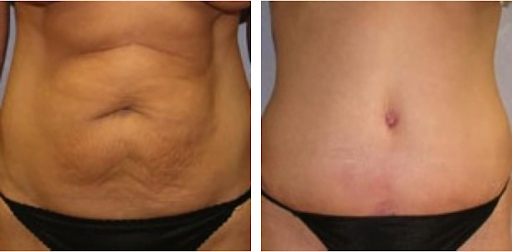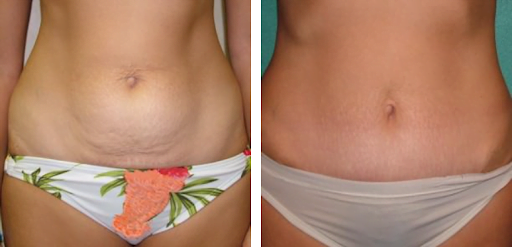Regular vs. Mini Tummy Tuck: Which is Right for Me?

Both men and women seek tummy tucks to address issues like stretched abdominal muscles (diastasis recti) or excess skin that lingers after significant weight loss or pregnancy. Achieving a Natural Look™ with cosmetic surgery requires a completely personalized approach, and so we offer two tummy tuck techniques to correct aesthetic and, often, functional issues in the midsection.
Depending on your unique needs, Cincinnati cosmetic surgeons Dr. Mandell-Brown and Dr. Gina Maccarone will recommend either a regular tummy tuck or a mini tummy tuck during your consultation. In the meantime, here is a quick overview to give you an idea of which procedure could be the right fit for your body and goals.
Regular Tummy Tuck: The gold standard
A full tummy tuck, also known as abdominoplasty, removes excess skin and fat from the abdominal area and tightens the muscles of the abdominal wall. The skin and muscles are tightened from the rib cage to the pelvis. This technique is particularly beneficial if you have a considerable amount of excess skin or require significant diastasis recti (stretched abdominal muscles) repair after weight loss or childbirth.
Who can benefit from a standard tummy tuck?
Good candidates for a standard tummy tuck are men and women who have loose skin and pockets of fat above and below the belly button—which consequently may also appear distorted or stretched. Ideal candidates for a regular tummy tuck may also identify with the following:
- You have a protruding abdomen.
- You have upper and lower abdominal muscle separation.
- You have physical activity limits due to a lack of optimal muscle functionality.
- You may be limited in clothing choices.
- You have some chronic back pain. Patients with a strengthened core from the full tummy tuck have noted improvement in back pain. We emphasize that this is a secondary benefit and not a guarantee

Standard tummy tuck recovery
Recovery from a standard tummy tuck requires 8-14 days of focused recovery. You’ll have surgery drains placed to help speed recovery, and Dr. Mandell-Brown and Dr. Maccarone will remove the drains at your 1-week post-op appointment. You’ll also wear a compression garment to hold your improved shape for several weeks and to minimize post-surgery swelling.
Depending on the job requirements, many people return to sedentary work after a week, while others prefer 10-14 days before returning to work. You’ll need to maintain a slightly bent position at the waist to avoid straining your suture line—which extends from hip to hip—for about two weeks, so some patients wait until they can stand upright before returning to in-person workplaces. We request that you sleep in a “beach chair” position for six weeks following surgery.
Why you may choose this technique over a mini tummy tuck
A standard tummy tuck can address more aesthetic and functional concerns comprehensively, so if you want to see improvement in the top and bottom portions of your abdomen, Dr. Mandell-Brown and Dr. Maccarone will use a full tummy tuck to sculpt a natural silhouette that complements your overall anatomy and brings balance to your appearance. Most patients find that their tummy tuck results are well worth a longer incision and slightly longer recovery.
Mini Tummy Tuck: Less can be more
A mini tummy tuck, or partial abdominoplasty, targets excess skin, unwanted fat, and stretched abdominal muscles primarily located below the belly button.
Who should consider a mini tummy tuck?
Good candidates for a mini tummy tuck are men and women who are generally satisfied with the appearance and muscle tone of their upper abdomen but have a small “pooch” or excess skin in the lower abdomen. The belly button is not repositioned during a mini tummy tuck, so it’s important that you are happy with your belly button’s position and appearance.

Mini tummy tuck recovery
The recovery from a mini tummy tuck is usually quicker than that of a standard tummy tuck, requiring between 7-10 days of downtime. That said, you will still have surgery drains for the first 3-7 days and a compression garment to support healing tissues and speed recovery. Most patients return to work within 1-2 weeks, usually with less discomfort and swelling to manage compared to a full tummy tuck. During your post-op appointments, Dr. Mandell-Brown will clear you for certain activities as your body is ready; most patients typically require 4-6 weeks of light activity only.
Why you may choose this procedure over a regular tummy tuck
A mini tummy tuck could be the more suitable procedure if we can achieve both the aesthetic and functional goals you desire for your midsection without the comprehensive approach of a full tummy tuck. Because it is a less extensive procedure, a mini tummy tuck can be performed under IV sedation instead of general anesthesia.
While many surgeons do not correct stretched abdominal muscles during a mini tummy tuck, the extensive experience and meticulous surgical skill of Dr. Mandell-Brown and Dr. Maccarone allow them to address lower abdominal muscle separation using the shorter mini tummy tuck incision.
A third tummy tuck technique that is occasionally recommended is the Flor de Lis abdominoplasty. In this procedure, we use a vertical incision and a horizontal incision to remove more excess skin. This upside-down “T” incision removes the maximum amount of skin and is especially suited for massive weight loss patients with significant excess skin. Our surgeons will discuss the benefits of the Flor de Lis tummy tuck vs. waiting to see if, after healing, a vertical incision is required for further tightening.
About the Mandell-Brown Plastic Surgery Center
Dr. Mark Mandell-Brown and Dr. Gina Maccarone bring years of expertise, artistry, and compassionate care to every procedure. The team at our Cincinnati plastic surgery practice is recognized as the best in the Cincinnati / Dayton area, and we’re committed to helping you look better, not different.
Our surgeons thoughtfully customize every aspect of your surgery, from placing your incisions for easy concealment to making countless adjustments to maintain a natural appearance—Dr. Mark Mandell-Brown and Dr. Gina Maccarone have been named “Best in Plastic Surgery” by CityBeat Magazine and the Cincinnati Enquirer for several years and counting! Most recently, the Mandell-Brown Plastic Surgery Center was named the Best of the Best in the 2023 Cincinnati Enquirer Community Choice Awards as well as Dr. Mandell-Brown being voted Best of the Best for Cosmetic/Plastic Surgeons.
When you book a consultation at the Mandell-Brown Plastic Surgery Center, you’ll receive a thorough evaluation and professional recommendations from surgeons who are easy to talk to and value an open and honest patient connection. Please call our practice at 513-984-4700 or contact us online today.


